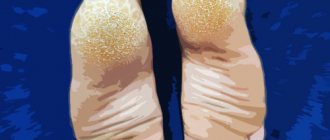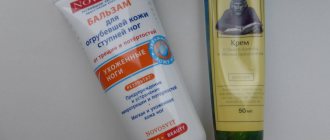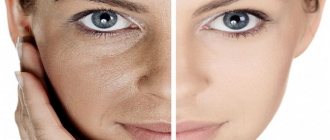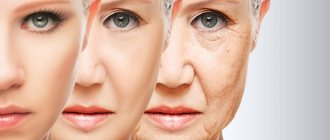Cracks in the feet rarely appear suddenly. As a rule, the appearance of such a crack is preceded by symptoms such as dryness and flaking of the skin. If the patient does not pay attention to these signs in a timely manner, the top layer of skin may rupture - a crack appears.
Depending on the depth of the cracks, podiatrists distinguish between superficial and deep cracks in the feet. Experts warn that if even superficial cracks appear, you must seek qualified medical help.
Many patients prefer to independently select remedies to solve the problem of cracked feet. However, such tactics will not bring the desired result - it is necessary, first of all, to identify the cause of the cracks and only then select the treatment methods necessary in each individual case.
Medical certificate
According to scientific research in recent years, the basis for beautiful and attractive skin is a balanced diet. To maintain her health, only cosmetics or pharmaceutical products are not enough. A deficiency of certain vitamins may be indicated by such signs as dry skin on the feet and cracked heels. To stop the problem, as a rule, it is enough to change your daily diet. Additionally, you can use various creams and ointments, alternative medicine recipes.
Vitamin deficiency is the cause of cracked heels
A deficiency of certain vitamins in the body often leads to cracks in the feet. For example, a lack of vitamin A can cause excessive dryness of the skin and roughening. As a result, cracks and calluses begin to form. Vitamin E prevents tissue destruction and excessive capillary fragility, and helps normalize metabolism. This makes the skin not only healthy, but also beautiful.
Vitamin F has an anti-inflammatory effect.
It accelerates the regeneration process, promotes the healing of wounds and ulcerative lesions. With a lack of vitamin PP, the body's protective properties are reduced, sometimes this process is accompanied by severe skin itching and peeling.
When the first symptoms occur, you need to reconsider your daily diet. It will be useful to include a variety of vegetables and fruits, herbs. Additionally, you can take vitamin complexes and well-chosen dietary supplements. In some cases, the use of creams with additives will be required.
Vitamins A and C
With a severe deficiency of vitamin A in the body, the skin begins to dry out quickly, losing its elasticity. As a result, cracks appear on the heels. Among the main causes of vitamin A deficiency are:
- unbalanced diet and improper metabolism;
- diseases of the stomach, intestines, liver;
- pregnancy period;
- pathologies of the endocrine system.
Vitamin A “works” in the body only with vitamin E. A lack of the latter can lead to its deficiency. The risk group includes people with diabetes mellitus and various circulatory disorders.
Vitamin C or ascorbic acid is another substance that works as an antioxidant. In addition, it helps the body produce collagen. Aging or sun-damaged skin has low levels of vitamin C. Since this substance helps the epidermis retain moisture, its deficiency can lead to dehydration and subsequent dryness of tissue cells, including in the heel area.
In developed countries, this disorder is rarely encountered. For deficiency to occur, you must consume less than 10 mg of the vitamin daily for several weeks or even months. However, it is found in large quantities in products that can be found on the tables of ordinary families. First of all, these are strawberries, oranges, cabbage, kiwi and red peppers.
Vitamin E
Vitamins of group E play the role of a natural antioxidant. They protect cells and help them function longer. In addition, they support skin health and immune system function.
Collagen is considered an important component of the skin. This substance prevents early aging caused by natural biological processes.
As we age, collagen synthesis decreases by approximately 1% annually.
As a result, the epidermis loses its elasticity and firmness. Dry skin is one of the main causes of cracked heels. Vitamin E promotes the formation of collagen fibers. Natural sources include sunflower seeds, cereal sprouts, brown rice, spinach, beets and corn oil. Vitamin E deficiency is usually encountered by people suffering from various gastrointestinal pathologies. Gastrointestinal disorders do not allow this component to be fully absorbed.
Vitamin B3
Vitamin B3 is also known by another name - niacin. This substance plays an important role in energy metabolism. Without it, the body cannot fully convert food into energy for use by the body. Foods rich in niacin include ground beef, brown rice, avocados and lentils.
Niacin is also an antioxidant. It fights free radicals. When their level becomes high enough, the risk of developing diseases, including malignant ones, increases.
If there is not enough B3, doctors often diagnose pellagra. One of the symptoms of this condition is dry and flaky skin. Pellagra initially affects areas of the body that are most exposed to sunlight. If your heels are not exposed to increased UV radiation, the symptoms of pellagra may not be noticed. First, the pathology will spread to other parts of the body and only after some time will it appear on the feet.
Other causes of pathology
A deficiency of certain vitamins is not the only reason why cracks appear on the heels over time. This problem is especially common in the summer, when people walk barefoot or prefer open shoes.
The external environment has an adverse effect on the skin. As a result, it loses its elasticity, and the stratum corneum cracks.
Among the pathological causes of this disorder, doctors most often have to deal with obesity.
Excess body weight negatively affects the functioning of major systems and organs, causing circulatory disorders and thinning of the skin. The development of diabetes may be accompanied by neuropathy, which is also characterized by changes in the skin in the foot area. A disease such as psoriasis spreads to various parts of the body, including the heels, causing irreversible damage to the epidermis.
Localization of cracks
These areas of the foot are most susceptible to cracks in the skin:
- heel - cracks on it cause pain when walking and are usually a consequence of non-compliance with hygiene rules; they also often occur in those who walk barefoot a lot;
- on the big toe - can signal the presence of a fungal infection, metabolic disorders, and a number of diseases;
- between the fingers - a consequence of a fungal infection, diabetes, thyroid diseases, etc.
General treatment recommendations
If the quality and appearance of the skin on your heels deteriorates, you should consult a doctor. A specialist will be able to find out the cause of the disorder and recommend therapy. However, it is also important to monitor your heels daily at home.
Pre-softened skin should be cleaned daily with a pumice stone or an abrasive brush to remove the stratum corneum. After hygiene procedures, it is important to apply moisturizer. If you feel particularly dry, you can wear socks at night. It is better to avoid flip-flops and sandals, which additionally injure damaged skin while walking.
Treatment is largely determined by the cause of cracked heels. Doing baths or compresses at home is only allowed if the damage is not severe. For foot fungus or diabetes, special medications are prescribed. They protect the skin and have an antibactericidal effect. With a slight deficiency of vitamins, it may be enough to adjust the diet, but it is better to take vitamin complexes or dietary supplements.
Cracks on the feet
Cracks are an obligatory companion to hyperkeratosis of the feet. Excessively thick skin that has lost its elasticity can no longer resist the loads that arise when walking as effectively as before. Cracks appear in places of greatest pressure. Their favorite location is the heels.
Typically, the crack is wider at the surface of the skin and narrows deeper. With prolonged existence, the edges of the cracks also become keratinized and thickened.
However, this does not lead to a cure. On the contrary, when walking, such a crack deepens even more and begins to bleed. In severe cases, cracks can reach the bone.
Pharmacy drugs
Modern medicine has a wide range of drugs that can get rid of cracked feet in the shortest possible time. It is better to select a specific remedy together with your doctor. The creams and ointments from the table below are characterized by the greatest effectiveness.
| Name | Description of the drug | Price |
| Radevit | The ointment contains tocopherol, ergocalcium, retinol and other vitamins. These substances help restore the skin and kill existing infections, preventing them from developing. The ointment nourishes and moisturizes well, speeds up the healing process. Apply it in a thin layer, and always put a bandage on top. | 385 rubles |
| Flexitol | This drug is designed for patients with deep heel injuries. The ointment relieves inflammation and itching, restores the skin. It is especially recommended for patients with diabetes. Before applying, it is advisable to treat your feet with a disinfectant. Visible improvements become noticeable after 3 days. | 482 rubles |
| Gewol | The product is used for diabetes, burns, and varicose veins. It nourishes and moisturizes the skin well and has a healing effect. In addition, it has an analgesic effect and eliminates unpleasant odor. Among the components of the drug, panthenol should be highlighted - a substance that promotes rapid healing of the epidermis. | 648 rubles |
It is not recommended to select the medicine yourself. Many of them have contraindications for use. Therefore, it is better to trust the help of a qualified specialist.
Folk remedies
Alternative treatment often turns out to be more effective than pharmaceutical drugs, especially at the initial stage of the pathology. This is due to the natural ingredients contained in home remedies. They rarely cause side effects and have virtually no contraindications.
Treatment with vitamin A and calendula ointment is considered especially effective. This plant has a pronounced healing effect. In combination with liquid vitamin A, the ointment allows cracks to heal quickly and painlessly, leaving the skin soft and healthy. All ingredients are sold at the pharmacy. They must be mixed in the following proportion: 10 ml of vitamin to 20 ml of calendula ointment. The product is applied in a thick layer and left until completely absorbed; you can put socks on your feet.
Foot baths
Foot baths also have a visible effect. For the procedure, extracts of calendula, chamomile, string, and oak bark are used. Other recipes are also popular:
- Sodium bicarbonate
. Dissolve 3 tablespoons of baking soda in warm water. Feet should be kept for no more than 15 minutes, and then wiped well with a towel. With regular procedures, cracks heal quickly. - Salt and lemon juice
. In 2 liters of slightly warmed water you need to add a tablespoon of sea salt and a small amount of lemon juice. Keep your feet in the resulting infusion for no more than 15 minutes. Then they should be dried with a towel and any moisturizer should be applied.
Blood circulation in the lower extremities is well improved by contrast procedures. First, you need to warm your feet in socks, then lower them into the water.
Its temperature should be no more than 30 degrees. After a few minutes, slightly warmed water can be added to the container. When its temperature reaches 45 degrees, it is recommended to immerse your feet in cold water for 5 seconds, and then in hot water. Such manipulations should be repeated several times.
How to Cleanse Rough Skin with Foot Baths
A relaxing foot bath with salt and oils is a complete spa treatment that you can do at home at any time. By following the instructions, you will soften rough skin, relieve fatigue and enjoy foot care.
First you need to fill a container with hot water at a comfortable temperature, about 37-39 degrees. Dissolve the bath mixture in it at the rate of 1 tablespoon for every liter of water. 15-20 minutes are enough to steam the skin. Don't keep your feet in the water for too long, otherwise the water will cool down and you will get the opposite effect.
After steaming, you can start working with a file, grater and pumice. There may be a lot of skin at first, don't let that worry you.
Finish the treatment with a relaxing foot massage. Stretch each foot separately, rubbing it from heel to toes and back. Rub and twist each finger. Press the edges of your foot several times. Apply precise pressure and rub your foot, moving through all areas from the heel to the toes. Massage the heel with circular movements and pinching. At the end, you can stroke it and twist your leg a little in the joint.
After such a massage, local blood circulation in the feet improves, fatigue and swelling go away, and the skin well absorbs all the beneficial substances from the oil or cream. At night, the body undergoes the most active regeneration, so we recommend performing the procedure before bed.











